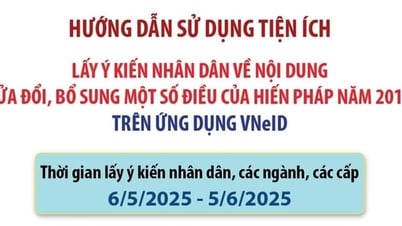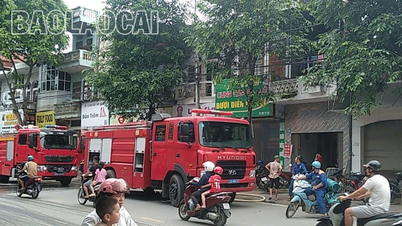According to the forecast of the Ministry of Home Affairs , after the process of rearranging and streamlining the political apparatus, a large number of civil servants and public employees will leave the public sector and move to the private sector, which will also create no small pressure in strengthening connections to the labor market.
Mr. Vu Trong Binh, Director of the Department of Employment (Ministry of Home Affairs) informed that in the first phase of streamlining the apparatus of ministries, branches and localities, it is expected that about 100,000 civil servants and public employees will be affected. This is a group of experienced human resources, adding significant human resources to the labor market.

A large number of civil servants and public employees will leave the public sector and move to the private sector, which will also create significant pressure on strengthening labor market connectivity (Illustration photo)
Currently, the Department of Employment has directed local employment service centers to connect and introduce jobs for this group of workers. In addition, the Department is also researching and proposing policies, training, loans, and job support for civil servants and public employees after leaving the public sector.
Regarding the arrangement and merger of provinces in the coming time, Mr. Vu Trong Binh said that the Department of Employment is coordinating with units in the Ministry of Home Affairs to obtain data. Currently, there are no exact figures on how many workers have left the public sector as well as their professional qualifications and locations to group and classify them to connect with businesses to introduce new jobs.
“There are many different groups of workers, there are young workers, there are workers over 50 years old, so there needs to be different responses in the policy mechanism for each of these groups,” said Mr. Binh.
The Director of the Department of Employment said that only when the right target is assessed can we effectively connect, support, or lend capital to groups of civil servants and public employees leaving the public sector.
According to the Department of Employment, there are currently about 54 million workers nationwide, so the number of people affected by the restructuring of the state apparatus is about 100,000 people. If viewed from the perspective of workers, it is very important to pay attention to support policies. However, these 100,000 people will be distributed in many different industries and occupations, spread across 63 provinces and cities, so it will not create major fluctuations in the labor market.
“With the second round of reorganization, we will continue to assess the number of affected workers, including the number, the personal impact of civil servants and public employees leaving the public sector, and the impact on the supply of high-quality human resources. However, considering the overall impact on quantity, we predict that like the first round of 100,000 people, this round will not cause disruption to the labor market,” said Mr. Binh.
Mr. Vu Quang Thanh, Deputy Director of the Hanoi Employment Service Center, said that the number of workers who will soon quit their jobs due to the process of restructuring and streamlining the apparatus is a highly qualified workforce with a lot of practical experience, an abundant source of human resources for domestic and foreign enterprises. However, retraining this group to suit the practical requirements of enterprises needs to be based on specific assessments and surveys.
Mr. Thanh said that retraining civil servants and public employees after restructuring will depend on the job position, job requirements, and existing qualifications of the employee. Effective job matching also requires a clear assessment of capacity and skills compared to the requirements of the business.

Businesses and workers connect at job introduction session
According to Mr. Vu Quang Thanh, the Hanoi Employment Service Center is and will continue to coordinate with relevant agencies and units to compile statistics and help connect businesses and civil servants after they leave the public sector.
Regarding the issue of receiving unemployment insurance when leaving the public sector without a new job, Mr. Vu Quang Thanh instructed that employees can submit their unemployment insurance application directly at the reception points of the Employment Service Centers of provinces and cities or submit it online via the National Public Service Portal.
“For Hanoi, the Hanoi People's Committee encourages workers to submit their applications online to save time, limit travel and ensure more convenience in the process of resolving the regime,” said Mr. Thanh.
Mr. Thanh also noted that, in addition to completing procedures to receive unemployment insurance, workers who come to implement the unemployment insurance policy can also participate in activities providing labor market information and job transactions to quickly connect with businesses and return to the labor market.
According to the provisions of the Law on Employment, after receiving unemployment insurance, workers will be supported with counseling, job referrals and vocational training. If they register for vocational training, they will be supported with primary vocational training for a maximum period of no more than 6 months.
According to Vietnam Social Security, when employees participate in unemployment insurance, when they quit their jobs, they will receive unemployment insurance benefits, including unemployment benefits, vocational training, job counseling, etc. If employees take a lot of time off, the Unemployment Insurance Fund will have to spend more. However, the Unemployment Insurance Fund currently has a surplus of more than 60,000 billion VND. Therefore, for employees and employees who quit their jobs when the apparatus is streamlined, the Unemployment Insurance Fund still ensures the ability to pay.
The current Employment Law stipulates that within 3 months from the date of termination of the labor contract or employment contract, the employee must submit an application for unemployment benefits to the Employment Service Center established by the State management agency for employment. If the application is submitted after 3 months, the Employment Service Center will refuse to process it and return the application to the employee. However, the previous insurance payment period will be retained and added to the next period in which the employee pays unemployment insurance, until the employee is eligible for unemployment insurance for the next time.
Source: https://baolaocai.vn/can-co-chinh-sach-voi-tung-nhom-cong-chuc-vien-chuc-thoi-viec-do-sap-xep-bo-may-post401457.html





![[Photo] Prime Minister Pham Minh Chinh and Prime Minister of the Kingdom of Thailand Paetongtarn Shinawatra attend the Vietnam-Thailand Business Forum 2025](https://vphoto.vietnam.vn/thumb/1200x675/vietnam/resource/IMAGE/2025/5/16/1cdfce54d25c48a68ae6fb9204f2171a)





















![[Photo] President Luong Cuong receives Prime Minister of the Kingdom of Thailand Paetongtarn Shinawatra](https://vphoto.vietnam.vn/thumb/1200x675/vietnam/resource/IMAGE/2025/5/16/52c73b27198a4e12bd6a903d1c218846)




























































Comment (0)